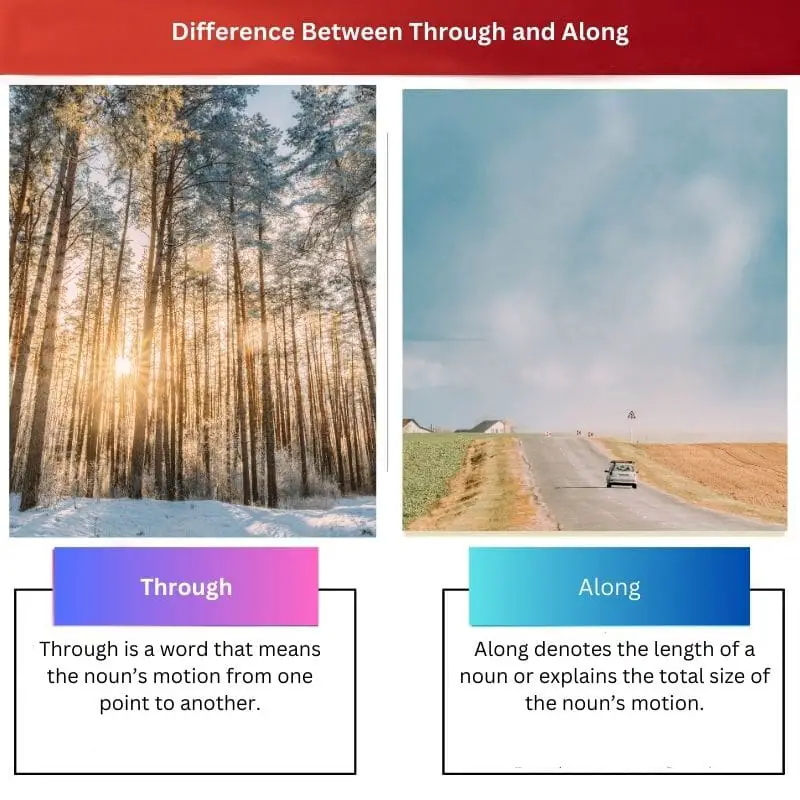Through and Along are used as prepositions and adverbs in coining sentences in the English language. ‘Through’ is the preposition used to denote a noun’s travel from one point to another. ‘Along’ is a preposition that is used to indicate the length of something.
Key Takeaways
- “Through” is a preposition indicating movement from one side of something to the other or across something, while “along” indicates movement in a continuous line following the length or direction of something.
- “Through” suggests a passage or movement within or across an object or space, while “along” implies movement parallel to or beside a path, road, or line.
- “Through” can also indicate the completion of an event or process, whereas “along” is strictly used to describe spatial relationships.
Through vs Along
Through indicates movement from one end of a space or a period of time to another, implying penetration or passage and emphasizes the idea of completion. Along indicates movement in a particular direction or a path, emphasizing the idea of continuation, and used when the emphasis is on direction.

‘Through’ can be a preposition, adjective, and adverb in English grammar. When it is used as an adjective, it describes the movement of the noun from one side to another.
‘Along’ acts as a preposition and an adverb in a sentence. When used as a preposition, it means the length of the subject or the lengthwise comparison of something.
Comparison Table
| Parameter of Comparison | Through | Along |
|---|---|---|
| Preposition | Through is a word that means the noun’s motion from one point to another. | Along denotes the length of a noun or explains the total size of the noun’s motion. |
| Adverb | As an adverb, through denotes the movement of something in a closed passage. | An adverb in sentences explains a noun’s company with something. |
| Dimension of motion | A 3-dimensional motion is meant when ‘through’ is used to denote the movement of something. | A linear motion of something is meant by using along in a sentence. |
| Parts of speech | Through can be a preposition, an adverb, and an adjective according to a particular context. | Along can be a preposition or an adverb according to the meaning intended. |
| Derived words | Throughout | Alongside, here along, there along |
When to Use Through?
The English language uses the word ‘through’ as a preposition in places where an opening and end of a location are meant. It means to enter something from its start and to come out of it by its end.
For example, The rat passed through the hole.
‘Through’ can be used as an adverb at places where the period of something is concerned. It explains the time needed to complete an ongoing task.
For example:
- This cab goes through Howrah.
Also, ‘through’ can be used as an adjective in sentences. Here ‘through’ means to complete a task to conclude a job by getting the output of it.
For example:
- He has done thorough work.

When to Use Along?
Along is also a preposition used to mention the travel of something from one point to another. But unlike ‘through’ along means only beside the said place, whereas through means in between the mentioned passage.
For example:
- They walked along the river.
When ‘along’ is used as an adverb, it can be used to mention the company of something or someone. It is used in sentences where the meaning of ‘being with’ is intended.
For example:
- She walked along with him
- There should be a park along this river.
Along can be used in many more contexts as many derived words exist. Alongside and Along with are some of the words that are worth mentioning.

Main Differences Between Through and Along
- As a preposition, ‘through’ is used in places where the path of travel of a noun is expected. Along is used in areas where the length or distance of the route is expected.
- Through means moving through a passage when used as an adverb, whereas ‘along’ means ‘being in company with’.

- https://dictionary.cambridge.org/dictionary/english/through
- https://dictionary.cambridge.org/dictionary/english/along

Highly informative and well-researched article. The clear explanations and examples make it easy to comprehend the distinctions between Through and Along.
I agree, this article is a fantastic guide for anyone looking to improve their understanding of English grammar.
A thorough comparison of Through and Along. The examples provided were especially useful in clarifying their differences.
Certainly, this article is an excellent reference for anyone looking to understand these prepositions.
The article provides a clear and concise explanation of the differences between Through and Along. This is an excellent resource for anyone learning English.
Yes, the comparison table and detailed explanation make it a valuable read.
This article takes a complex subject and simplifies it. The breakdown of ‘through’ and ‘along’ into various parts of speech is particularly helpful.
I couldn’t agree more. It made distinguishing between the two words much easier.
Definitely. The article provides a clear and methodical analysis of these prepositions.
It’s about time someone wrote an in-depth comparison of Through and Along. I’ve been looking for this kind of information everywhere.
I feel the same way. This article is a great resource for English learners.
Yes, this is a high-quality article that provides all the necessary information for a clear understanding.
This article is a game changer for understanding ‘through’ and ‘along.’ The detailed explanations and real-life examples offer great clarity.
Absolutely. It’s a must-read for anyone looking to enhance their English language skills.
Completely agree. The article’s thoroughness is commendable.
Great article, the article provides a comprehensive comparison of two confusing prepositions. It provides an in-depth explanation of when to use each preposition.
I agree, Through and Along can be really confusing, but this article helped me understand the difference.
I don’t think I’ve ever read a more comprehensive comparison of Through and Along. This is extremely helpful to understand the nuances of these words.
I completely agree, this article is very informative.
Absolutely. The definitions and examples provided make it easy to grasp the differences between Through and Along.
Informative and well-structured article. This really helped me understand the usage of Through and Along in English.
Absolutely. The article effectively breaks down the differences and usage scenarios.
An informative and insightful analysis of ‘through’ and ‘along.’ The comparison table really helped in understanding the different contexts of use.
Definitely. This article provides a comprehensive understanding of these prepositions.
I found the comparison table to be incredibly helpful as well.